1995 GMC SIERRA transmission
[x] Cancel search: transmissionPage 83 of 488

A CAUTION:
Shifting out of PARK (f) or NEUTRAL (N) while your engine is
“racing” (running at high speed) is dangerous. Unless your foot
is firmly on the brake pedal, your vehicle could move very
rapidly.
You could lose control and hit people or objects. Don’t
shift out of
PARK (P) or NEUTRAL (N) while your engine is
racing.
NOTICE:
Damage to your transmission caused by shifting out of PARK
(P) or NEUTRAL (N) with the engine racing isn’t covered by
your warranty.
AUTOMATIC OVERDRIVE (a) - This position is for normal
driving. If you need more power for passing, and you’re:
- Going less than about 35 mph (56 km/h), push your accelerator
pedal about halfway down.
the way down.
You’ll shift down to the next gear and have more power.
- Going about 35 mph (56 kdh) or more, push the accelerator all
0 should not be used when towing a trailer, carrying a heavy load,
driving on steep hills, or for off-road driving. Select THIRD
GEAR
(3) when operating the vehicle under any of these
conditions.
THIRD GEAR (3) - This is like 63, but you never go into Overdrive.
You should use
THIRD GEAR (3) when towing a trailer. carrying a
heavy load, driving on steep hills, or
for off-road driving.
0 SECOND GEAR (2) - This position gives you more power but lower
fuel economy. You can use
SECOND GEAR (2) on hills. It can help
control
your speed as you go down steep mountain roads, but then you
would also want
to use your brakes off and on.
If you manually select SECOND GEAR (2), the transmission will drive
in second gear. You may use this feature for reducing torque to the rear
wheels when you are trying
to start your vehicle from a stop on
slippery road surfaces.
2-21
ProCarManuals.com
Page 84 of 488
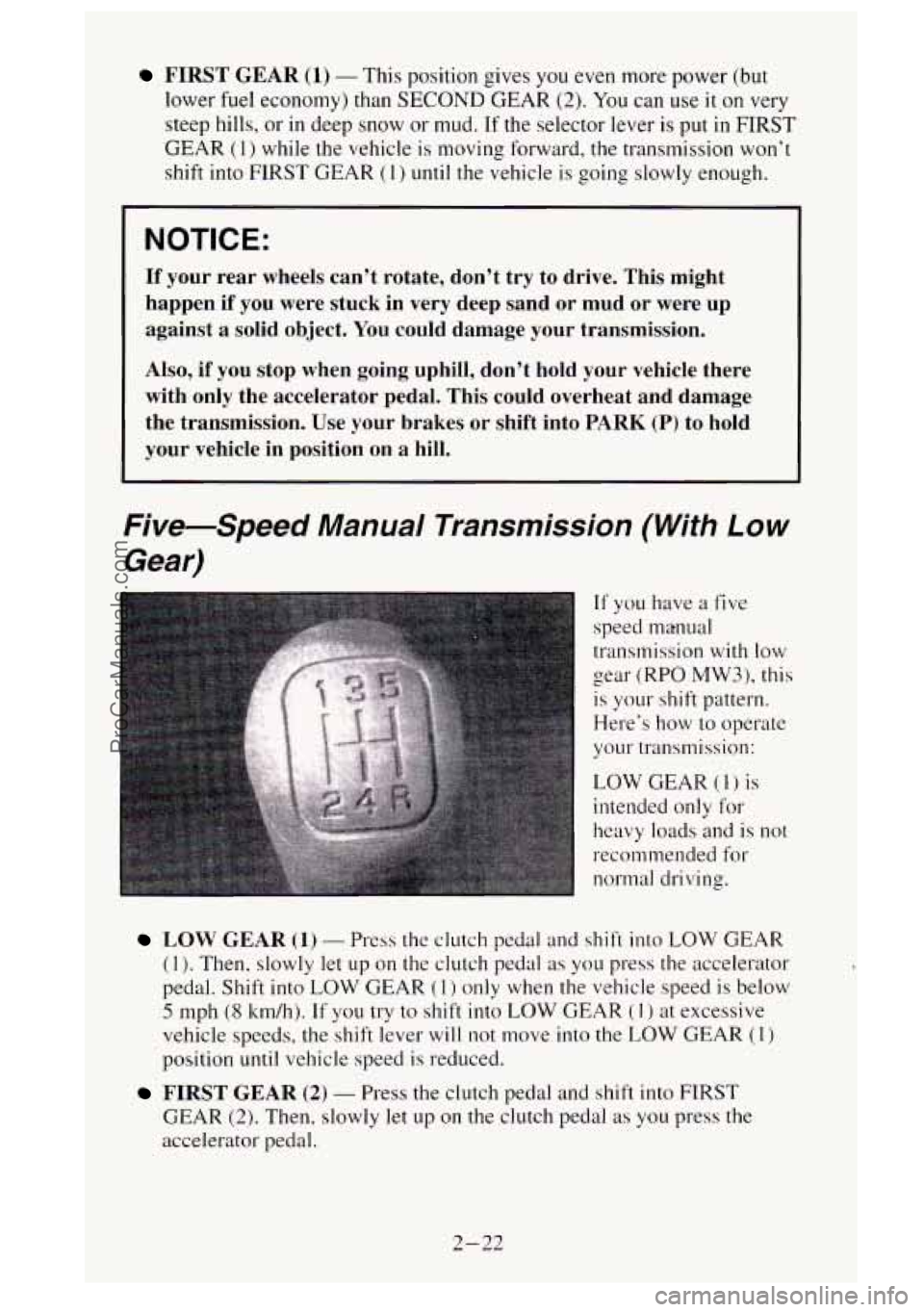
FIRST GEAR (1) - This position gives you even more power (but
lower
fuel economy) than SECOND GEAR (2). You can use it on very
steep hills, or in deep snow or mud. If the selector lever is put in FIRST
GEAR (1) while the vehicle is moving forward, the transmission won’t
shift into FIRST GEAR
(1) until the vehicle is going slowly enough.
NOTICE:
If your rear wheels can’t rotate, don’t try to drive. This might
happen if you were stuck in very deep sand
or mud or were up
against a solid object.
You could damage your transmission.
Also, if you stop when going uphill, don’t hold your vehicle there
with only the accelerator pedal. This could overheat and damage
the transmission.
Use your brakes or shift into PARK (P) to hold
your vehicle in position on a hill.
Five-Spa-ld Manual Transmission (With Low
Gear)
If you have a five
speed manual
transmission with
low
gear (RPO MW3), this
is your shift pattern.
Here’s how to operate
your transmission:
LOW GEAR (1) is
intended only for
heavy loads and is
not
recommended for
normal driving.
LOW GEAR (1) - Press the clutch pedal and shift into LOW GEAR
(1). Then, slowly let up on the clutch pedal as you press the accelerator
pedal. Shift into
LOW GEAR (1) only when the vehicle speed is below
5 mph (8 km/h). If you try to shift into LOW GEAR (I ) at excessive
vehicle speeds, the shift lever
will not move into the LOW GEAR (1)
position until vehicle speed is reduced.
FIRST GEAR (2) - Press the clutch pedal and shift into FIRST
GEAR (2). Then, slowly let up on the clutch pedal as you press the
accelerator pedal.
2-22
ProCarManuals.com
Page 85 of 488
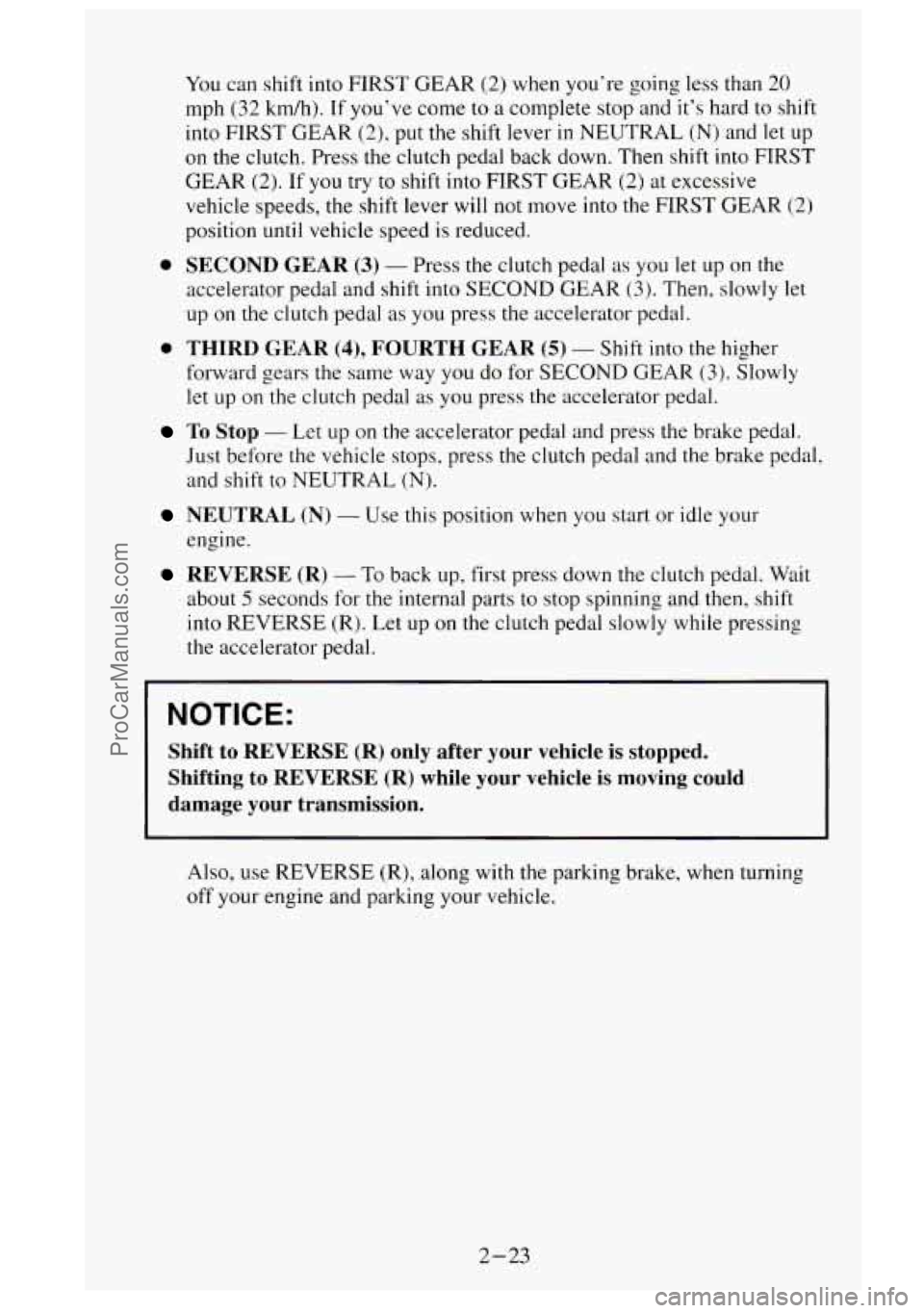
You can shift into FIRST GEAR (2) when you’re going less than 20
mph (32 kmh). If you’ve come to a complete stop and it’s hard to shift
into FIRST GEAR
(2), put the shift lever in NEUTRAL (N) and let up
on the clutch. Press the clutch pedal back down. Then shift into FIRST
GEAR
(2). If you try to shift into FIRST GEAR (2) at excessive
vehicle speeds, the shift lever will not move into the FIRST GEAR
(2)
position until vehicle speed is reduced.
0 SECOND GEAR (3) - Press the clutch pedal as you let up on the
accelerator pedal and shift into SECOND GEAR
(3). Then, slowly let
up on the clutch pedal as you press
the accelerator pedal.
0 THIRD GEAR (4), FOURTH GEAR (5) - Shift into the higher
forward gears
the same way you do for SECOND GEAR (3). Slowly
let up on the clutch pedal as you press the accelerator pedal.
To Stop - Let up on the accelerator pedal and press the brake pedal.
Just before
the vehicle stops, press the clutch pedal and the brake pedal,
and shift to NEUTRAL
(N).
NEUTRAL (N) - Use this position when you start or idle your
engine.
REVERSE (R) - To back up, first press down the clutch pedal. Wait
about
5 seconds for the internal parts to stop spinning and then, shift
into REVERSE (R). Let up
on the clutch pedal slowly while pressing
the accelerator pedal.
NOTICE:
Shift to REVERSE (R) only after your vehicle is stopped.
Shifting to
REVERSE (R) while your vehicle is moving could
damage your transmission.
Also, use REVERSE (R), along with the parking brake, when turning
off your engine and parking your vehicle.
2-23
ProCarManuals.com
Page 86 of 488
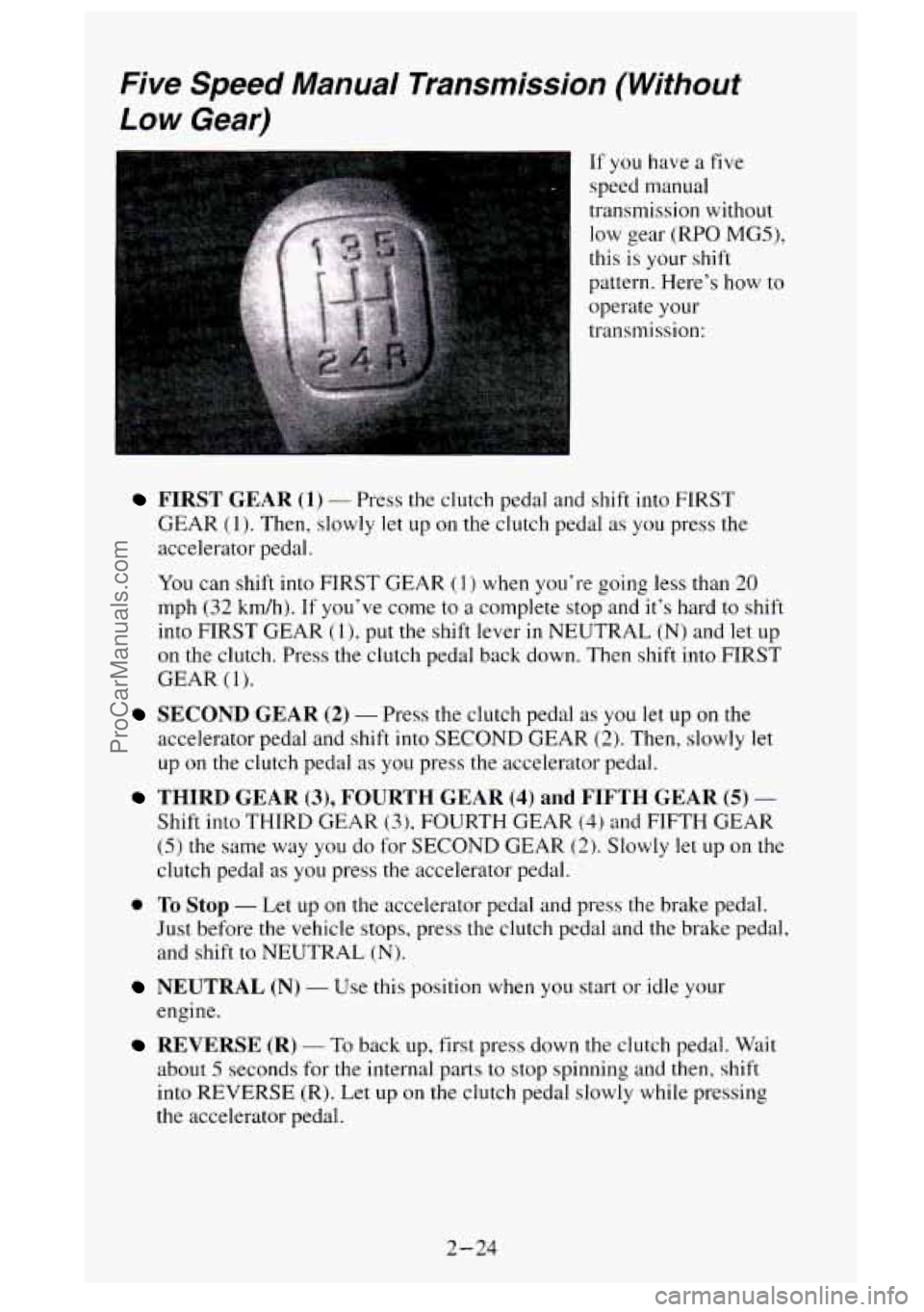
Five Speed Manual Transmission (Without
Low Gear)
6 If you have a five
speed manual
transmission without
low gear
(RPO MG5),
this is your shift
pattern. Here’s how to
operate your
transmission:
FIRST GEAR (1) - Press the clutch pedal and shift into FIRST
GEAR
(1). Then, slowly let up on the clutch pedal as you press the
accelerator pedal.
You can shift into FIRST GEAR (1 ) when you’re going less than 20
mph (32 kdh). If you’ve come to a complete stop and it‘s hard to shift
into FIRST GEAR
(1). put the shift lever in NEUTRAL (N) and let up
on the clutch. Press the clutch pedal back down. Then shift into FIRST
GEAR
(1).
SECOND GEAR (2) - Press the clutch pedal as you let up on the
accelerator pedal and shift into SECOND GEAR
(2). Then, slowly let
up
on the clutch pedal as you press the accelerator pedal.
THIRD GEAR (3), FOURTH GEAR (4) and FIFTH GEAR (5) -
Shift into THIRD GEAR (3). FOURTH GEAR (4) and FIFTH GEAR
(5) the same way you do for SECOND GEAR (2). Slowly let up on the
clutch pedal
as you press the accelerator pedal.
Just before the vehicle stops, press the clutch pedal and the brake pedal,
and shift to NEUTRAL
(N).
0 To Stop - Let up on the accelerator pedal and press the brake pedal.
NEUTRAL (N) - Use this position when you start or idle your
engine.
REVERSE (R) - To back up, first press down the clutch pedal. Wait
about 5 seconds for the internal parts to stop spinning and then, shift
into REVERSE (R). Let up on the clutch pedal slowly while pressing
the accelerator pedal.
2-24
ProCarManuals.com
Page 87 of 488
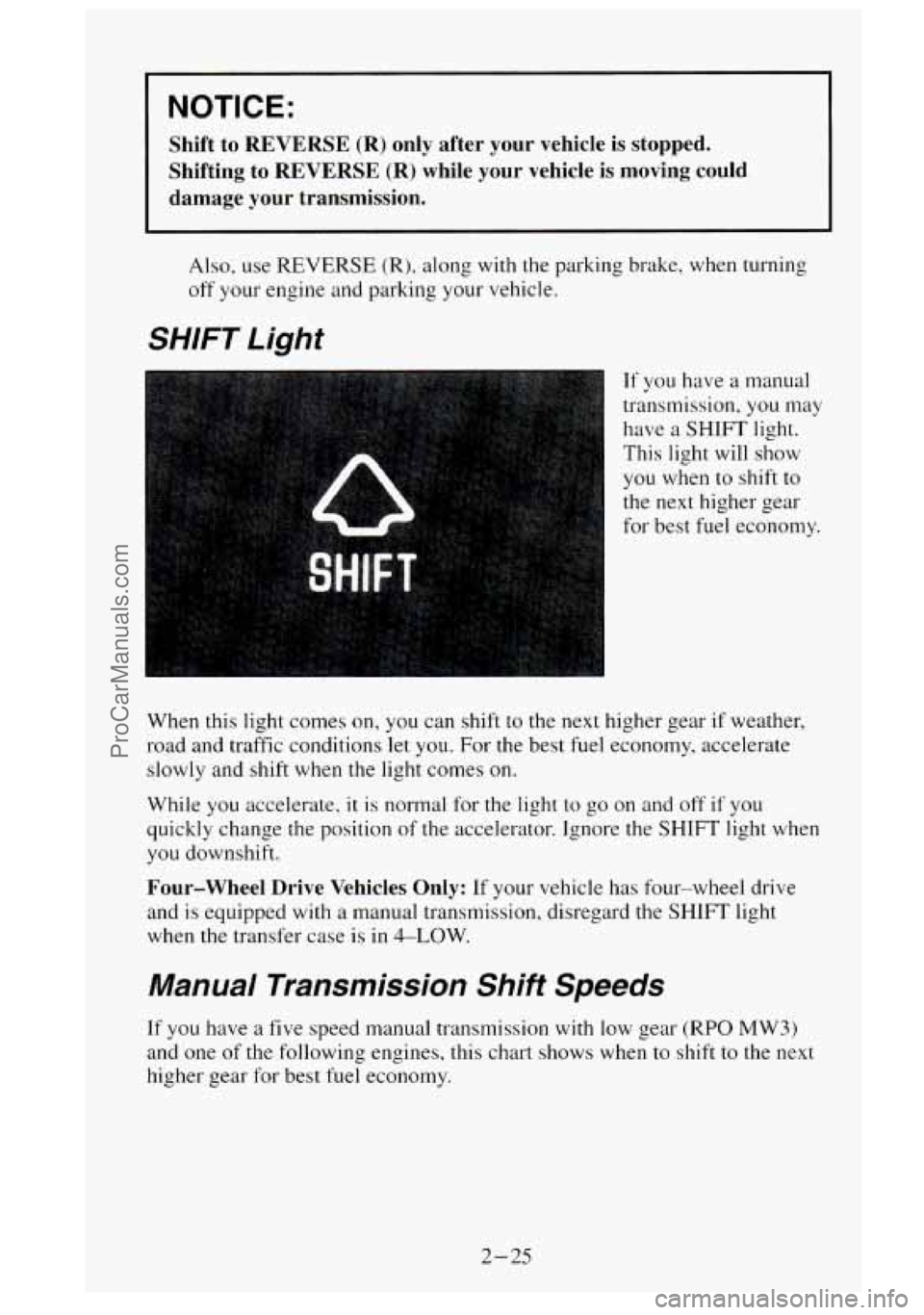
NOTICE:
Shift to REVERSE (R) only after your vehicle is stopped.
Shifting to REVERSE
(R) while your vehicle is moving could
damage
your transmission.
Also, use REVERSE (R), along with the parking brake, when turning
off your engine and parking your vehicle.
SHIFT Light
If you have a manual
transmission, you may
have
a SHIFT light.
This light will show
you when
to shift to
the
next higher gear
for best
fuel economy.
When this light comes on, you can shift to the
next higher gear if weather,
road and traffic conditions let you.
For the best fuel economy, accelerate
slowly and shift when the light comes on.
While you accelerate,
it is normal for the light to go on and off if you
quickly change the position of the accelerator. Ignore the
SHIFT light when
you downshift.
Four-wheel Drive Vehicles Only: If your vehicle has four-wheel drive
and is equipped with a manual transmission, disregard the
SHIFT light
when
the transfer case is in 4-LOW.
Manual Transmission Shift Speeds
If you have a five speed manual transmission with low gear (RPO MW3)
and one of the following engines, this chart shows when to shift to the next
higher gear for best fuel economy.
2-25
ProCarManuals.com
Page 88 of 488
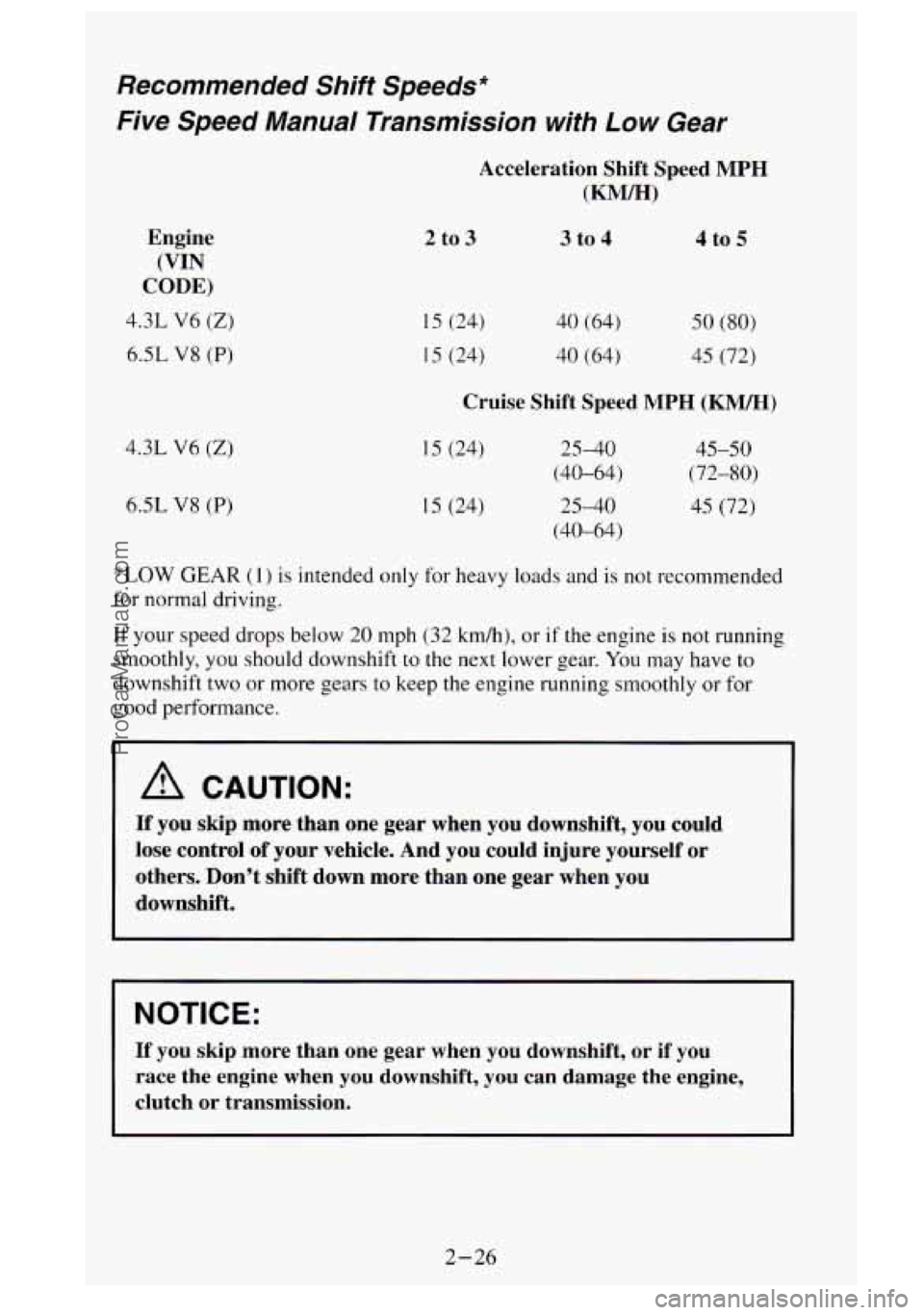
Recommended Shift Speeds*
Five
Speed Manual Transmission with Low Gear
Acceleration Shift Speed MPH
(KW)
Engine
(VIN
CODE)
4.3L V6 (Z)
6.5L V8 (P)
4.3L V6 (Z)
6.SL V8 (P)
2 to 3
15 (24)
1 5 (24)
3 to 4
40 (64)
40 (64)
4 to 5
50 (80)
45 (72)
Cruise Shift Speed MPH (KM/H)
15 (24)
I 5 (24) 25-40
(40-64)
25-40
(40-64) 45-50
(72-80)
45 (72)
*LOW GEAR (1) is intended only for heavy loads and is not recommended
for normal driving.
If your speed drops below 20 mph
(32 km/h), or if the engine is not running
smoothly,
you should downshift to the next lower gear. You may have to
downshift two
or more gears to keep the engine running smoothly or for
good performance.
A CAUTION:
If you skip more than one gear when you downshift, you could
lose control of your vehicle. And you could injure yourself or
others. Don’t shift
down more than one gear when you
downshift.
NOTICE:
If you skip more than one gear when you downshift, or if you
race the engine when you downshift, you can damage the engine,
clutch or transmission.
2-26
ProCarManuals.com
Page 90 of 488
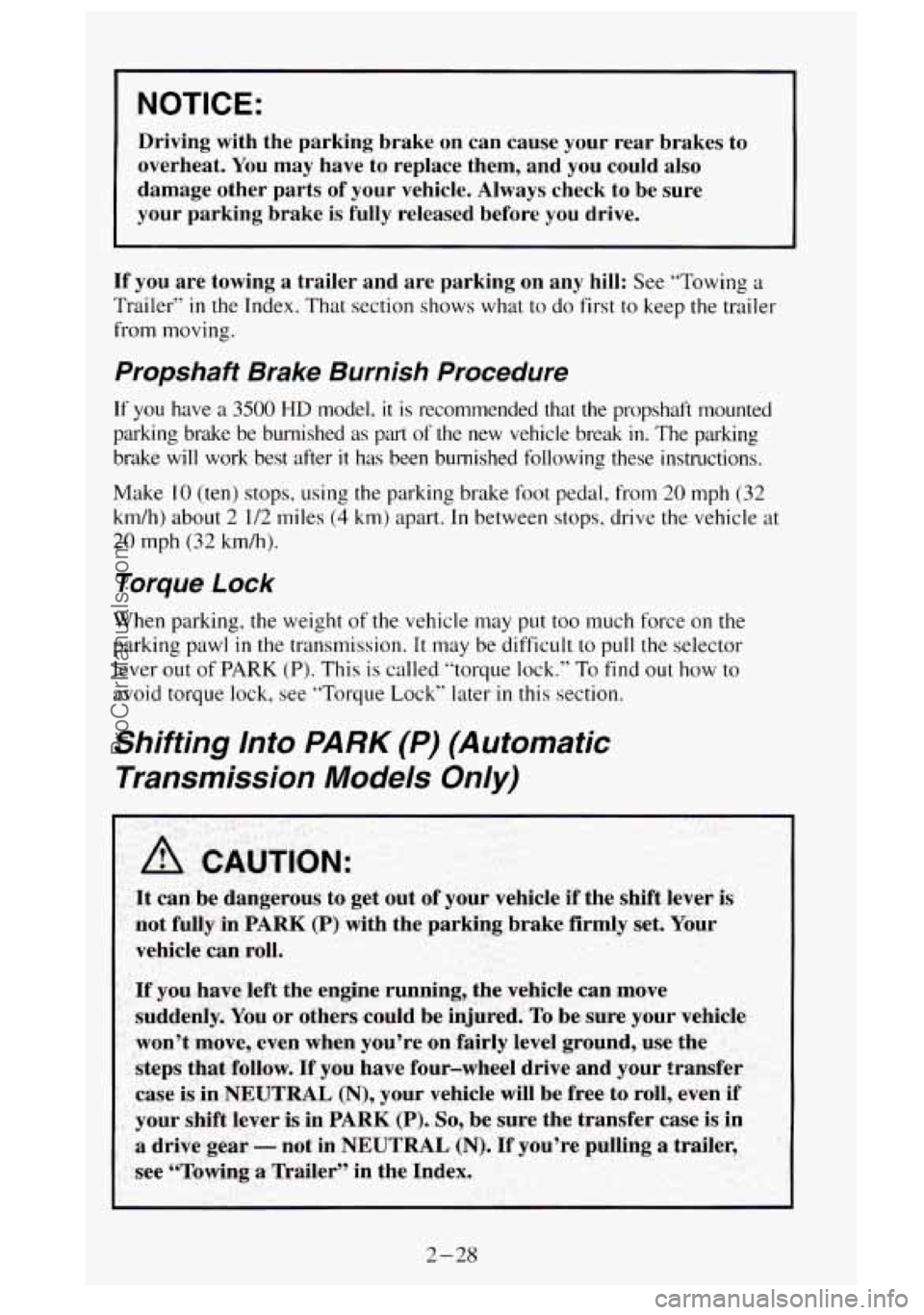
NOTICE:
Driving with the parking brake on can cause your rear brakes to
overheat. You may have to replace them, and you could also
damage other parts of your vehicle. Always check to be sure
your parking brake is fully released before you drive.
If you are towing a trailer and are parking on any hill: See “Towing a
Trailer” in the Index. That section shows what to do first to keep the trailer
from moving.
Propshaft Brake Burnish Procedure
If you have a 3500 HD model, it is recommended that the propshaft mounted
parking brake be burnished
as part of the new vehicle break in. The parking
brake will work best after
it has been burnished following these instructions.
Make
10 (ten) stops, using the parking brake foot pedal, from 20 mph (32
km/h) about
2 1/2 miles (4 km) apart. In between stops, drive the vehicle at
20 mph (32 km/h).
Torque Lock
When parking, the weight of the vehicle may put too much force on the
parking pawl
in the transmission. It may be difficult to pull the selector
lever out of
PARK (P). This is called ”torque lock.” To find out how to
avoid torque lock, see “Torque Lock” later in this section.
Shifting lnto PARK (P) (Automatic
Transmission Models Only)
2-28
ProCarManuals.com
Page 91 of 488
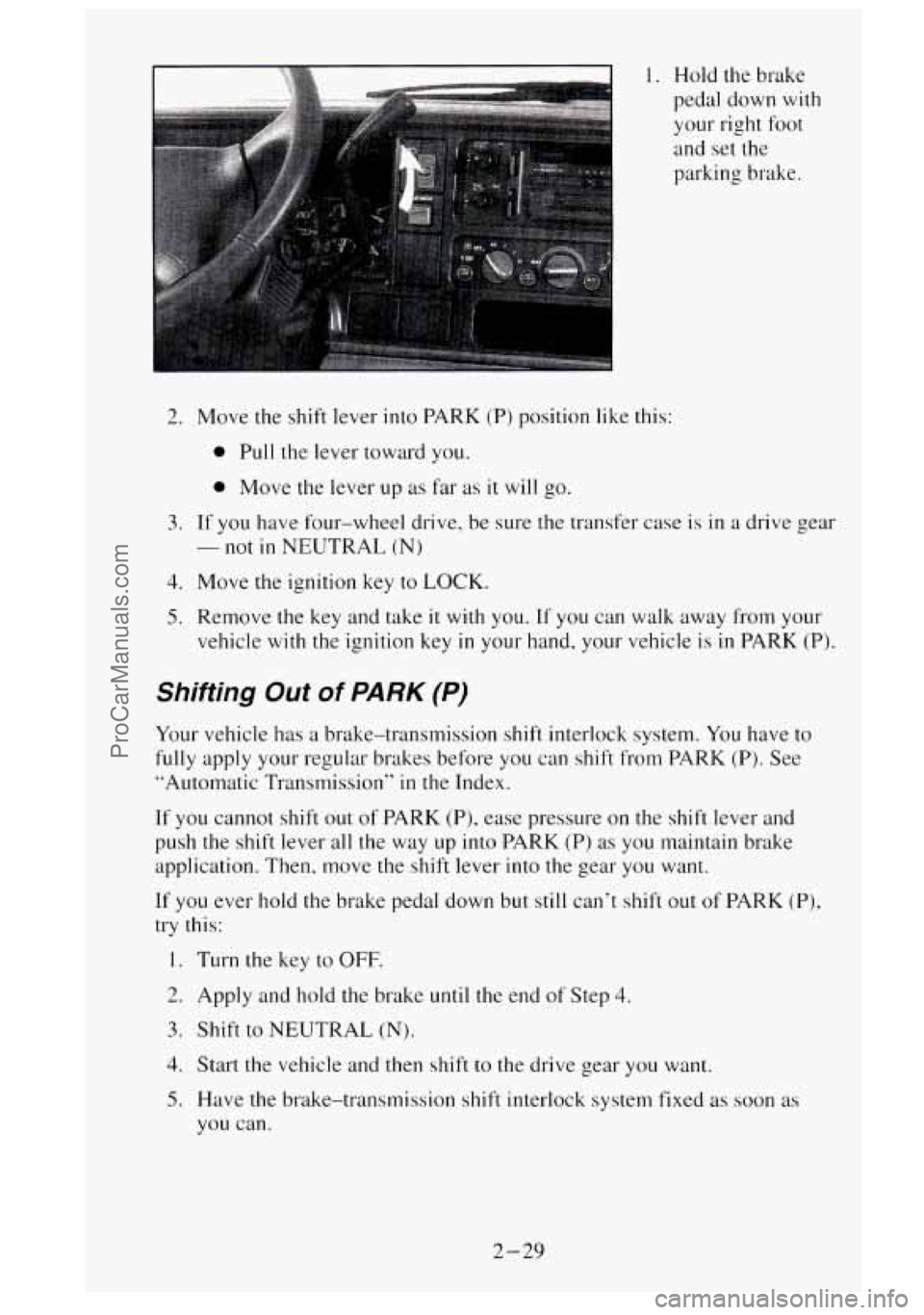
I. Hold the brake
pedal down
with
your right foot
and set the
parking brake.
2. Move the shift lever into PARK (P) position like this:
0 Pull the lever toward you.
0 Move the lever up as far as it will go.
3. If you have four-wheel drive, be sure the transfer case is in a drive gear
- not in NEUTRAL (N)
4. Move the ignition key to LOCK.
5. Remove the key and take it with you. If you can walk away from your
vehicle
with the ignition key in your hand, your vehicle is in PARK (P).
Shifting Out of PARK (P)
Your vehicle has a brake-transmission shift interlock system. You have to
fully apply your regular brakes before you can shift from PARK (P). See
“Automatic Transmission”
in the Index.
If you cannot shift out of PARK (P), ease pressure on the shift lever and
push the shift lever all the way up into PARK (P) as you maintain brake
application. Then, move the shift lever into the gear you want.
If you ever hold the brake pedal down but still can’t shift out of PARK (P),
try this:
1. Turn the key to OFF.
2. Apply and hold the brake until the end of Step 4.
3. Shift to NEUTRAL (N).
3. Start the vehicle and then shift to the drive gear you want.
5. Have the brake-transmission shift interlock system fixed as soon as
you can.
2-29
ProCarManuals.com